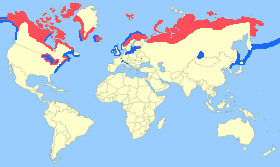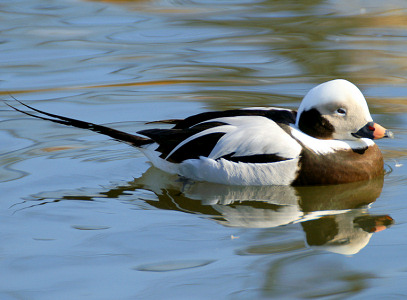Appearance:
Male - The male Long-tailed Duck has a mainly black and white plumage although this duck has a uniquely complex moulting process with three distinct plumage phases and the black and white plumage is seen over the winter and a chocolate brown and white plumage is seen in Spring and Summer, it has a distinctive long pointed tail, small dark-grey beak which has a pink band, and legs and feet are bluish-grey with darker webs.
Female - The female has a brown back, white head with dark crown and cheek patches, and a short pointed tail.
Size: - Typical Adult is about 44cm (17in).
Food: - Crustaceans, crabs, shrimps, molluscs, whelks, small fish and aquatic insects. Also pondweed, and grass seeds. It dives well staying submerged for up to a minute.
Habitat/Range: - Tundra pools, marshes, and coastal waters throughout the Northern Hemisphere's tundra and tundra-forest zones. Breeds further north than any other duck. Winters further south in the west and east coast of North America, Great Lakes, coastal areas of the UK and northern Europe (especially the Baltic Sea), and eastern Asia.

 Breeding Habitat/Resident,
Breeding Habitat/Resident,  Migration or Winter Area.
Migration or Winter Area.Breeding Season: - Mid-May further south, June in Iceland, and July in Arctic.
Eggs: - 5 to 9 (greyish-olive colour).
Notes: - The Long-tailed Duck is a medium-sized sea duck. It bears no relation to any other duck. Also known as 'Oldsquaw' in USA.
Conservation status (IUCN 3.1):
Vulnerable.
Classification: - Family: Anatidae,
Subfamily: Merginae, Genus: Clangula.



 photo by Neill Smith.
photo by Neill Smith.
